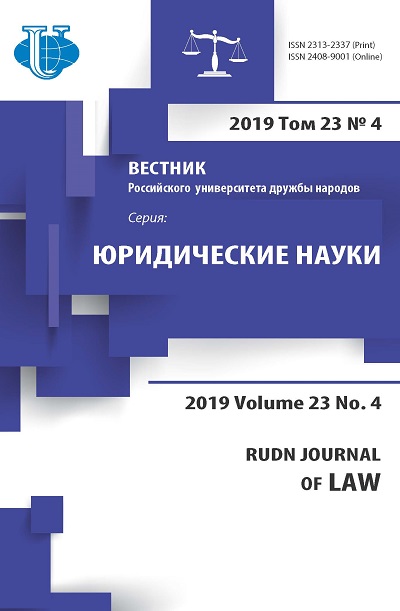PUBLIC SECURITIES AND DERIVATIVES LAW AS BRANCH OF THE FINANCIAL LAW
- Authors: Proshunin M.M.1
-
Affiliations:
- Russian State University of Justice
- Issue: Vol 23, No 4 (2019)
- Pages: 533-545
- Section: STATE AND LAW IN CONTEMPORARY WORLD
- URL: https://journals.rudn.ru/law/article/view/22497
- DOI: https://doi.org/10.22363/2313-2337-2019-23-4-533-545
- ID: 22497
Cite item
Full Text
Abstract
The article is devoted to financial law issues on securities and derivatives market regulations. The article deals with the financial law nature of the relations that are emerging in the securities and derivatives markets through a review of methods and techniques of securities and derivatives market regulation. The author considers the public interest in the regulation of the securities and derivatives markets, as well as differences between different parts of securities and derivatives markets. The article contains the review of regulatory, compensatory and redistributive functions of the securities and derivatives markets. The author states that control of the securities and derivatives market has to be considered as independent type of state financial control in the Russian Federation. In addition, the securities and derivatives law have to be considered as a branch of financial law. The legal relations arising in course of issuance and circulation of state securities and entering into derivatives deals are separately reviewed and analyzed. It is proved that the basis for recognition of the securities and derivatives market as the financial law categories is similar to reasons proving the existence of public banking law, namely, stock market and derivatives as an integral parts of any financial market system, the presence of public interest in the regulation of relations in the securities and derivatives markets, the existence of a mandatory subject of legal relations, having a public authority (the Bank of Russia), the existence of subordination between the Bank of Russia and professional participants of the securities market where the Bank of Russia acts as a regulator and supervisory authority and wide scope of public law methods used for securities and derivatives market regulations.
About the authors
Maxim M. Proshunin
Russian State University of Justice
Author for correspondence.
Email: mproshunin@mail.ru
Professor of the Faculty of Law of the Financial Department
69, Novocheremushkinskaya str., 117418, Moscow, RussiaReferences
- Andreeva, E.M. (2014) Pravovoe regulirovanie rynka tsennyh bumag [Legal regulation of the securities market]. Moscow: Yurlitinform Publ. (in Russian).
- Emirsultanova, E.E. (2005) Stock legal relations regulated by the norms of financial law. Financial law. 2005. No. 4. 38–42. (in Russian).
- Tsendiliani, I.A. (ed.) (2016) Finansovoe pravo [Financial law]. Moscow: Prospect Publ. (in Russian).
- Gracheva, E.Yu. (ed.) (2014) Finansovoe pravo [Financial law]. Moscow: Prospect Publ. (in Russian).
- Gabov, A.B. (ed.) (2011) Voprosy teorii i pravovogo regulirovaniya rynka [Securities: theoretical and practical questions of law regulations]. Moscow: Statut Publ. (in Russian).
- Getman-Pavlova, I.V. (2007) Legal constructions “international private currency law” and “international stock law”. International public and private law. (6), 2–5. (in Russian).
- Orlova, M.E., Shavaleeva, Ch.M. and others (2012) Gosudarstvenniy finansovy control [State financial control]. Moscow: Rid Grupp Publ. (in Russian).
- Krasnov, J.K., Alexandrov, A.A. (eds.) (2010) Gosudarstvennoe regulirovanie rynka cennykh bumag v Rossii i zarubezhnykh finansovykh centrakh [State regulation of the stock market in Russia and foreign financial centers]. MGIMO (University). Moscow: Statut Publ. (in Russian).
- Koval'kova, E.Y. (2017) Pravovoe regulirovanie rynka cennyh bumag [Legal regulation of the securities market]. Moscow: RGUP Publ. (in Russian).
- Lewis, M. (1989) Liar’s pocker. United States. W.W. Norton & Company Publ.
- Livshits, I.M. (2012) Legal regulation of securities market in the European Union. Moscow: Statut Publ. (in Russian).
- Kazantsev, N.M. (2009) Pravo i finansoviy control [Law and financial control]. Institute of Legislation and Comparative Law under the Government of the Russian Federation. Moscow: Eksmo Publ. (in Russian).
- Pristupko, A.O. (2006) Stock market in the system of financial and legal relations. Banking law.(2), 41–43. (in Russian).
- Kazantsev, N.M. (2009) Pravo i finansoviy control [Pravo and Financial Control]. Moscow: EKSMO Publ. (in Russian).
- Proshunin, M.M. (2016) Publichnoe fondovoe pravo kak institut finansovogo prava [Public stock law as the institute of financial law]. Public Law Mechanisms in Ensuring Social Development: Materials of the All-Russian Scientific and Practical Conference dedicated to the memory of Professor Nina Antonovna Kufakova. Moscow, 1 april 2016. Moscow: RUDN Publ. 151–159. (in Russian).
- Rozhdestvenskaya, T.E., Guznov, A.G. (2014) Public banking law. Banking law. (6), 6–17. (in Russian).
- Solnik, Bruno H. (1996) International Investments. Bruno Solnik. 3rd editional. Addison-Westley Publishing Company Publ.
- Sorkin, A.S. (2009) Too Big to Fail: The Inside Story of How Wall Street and Washington Fought to Save the Financial System from Crisis — and Lost. USA, New York: Penguin Group Publ.
- Tosunyan, G.A., Vikulin, A.Yu. (2003) To the new financial law. Financial law. (6), 15–19. (in Russian).
- Tropskaya, S.S. (2013) On the subject-matter of contemporary financial law. Financial Law. (12), 7–12. (in Russian).
- Zapolskiy, S.V. (2008) Diskussionnye voprosy finansovogo prava [Controversial issues of financial law theory] Monograph. Moscow: RAP. EKSMO Publ. (in Russian).
- Zapolskiy, S.V. (2010) Theory of Financial law: Scientific Essays. Moscow: RAP Publ. (in Russian).
Supplementary files















